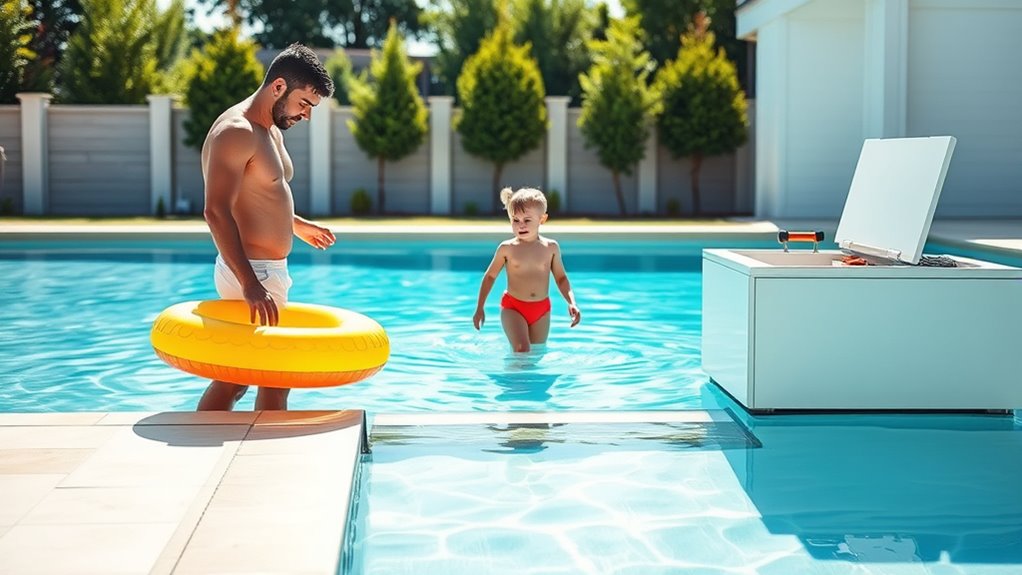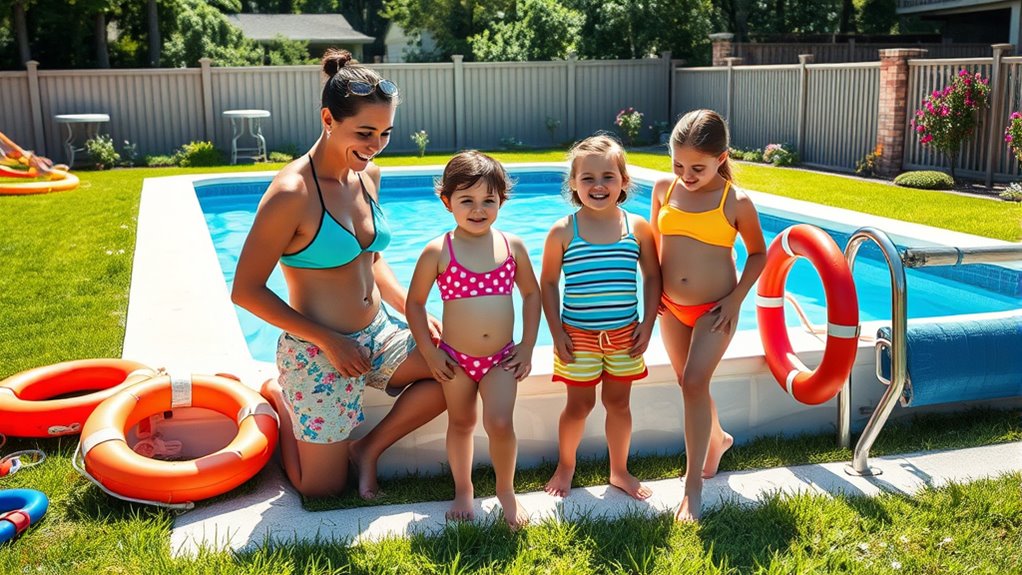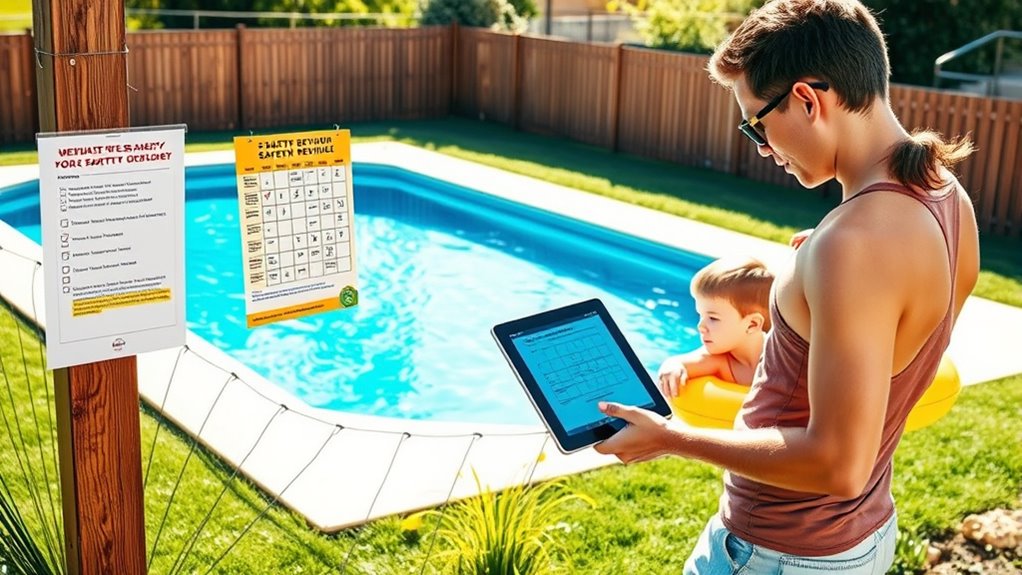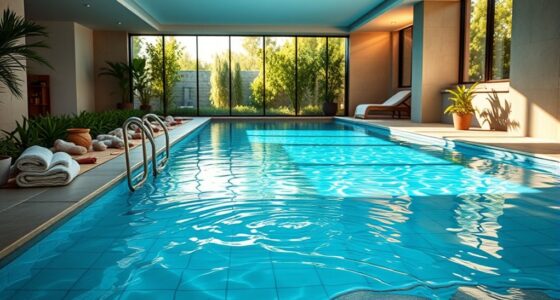To keep kids safe around the pool, handle safety tasks daily by checking water chemistry, supervising children, and ensuring safety equipment is accessible. Conduct weekly inspections of safety gear, the pool cover, and monitor water quality. Once a month, review safety system functions like alarms and covers, making upgrades if needed. Following this practical schedule helps prevent accidents and creates a secure environment—continue exploring to learn detailed routines for each level.
Key Takeaways
- Conduct daily safety checks of the pool area and water chemistry before children use the pool.
- Supervise children directly at all times whenever they are in or near the pool.
- Perform weekly inspections of safety equipment, pool cover, and safety alarms for proper function.
- Review and update safety protocols monthly, including testing alarms and ensuring safety gear is in good condition.
- Regularly monitor and address any hazards or malfunctions immediately to maintain a safe swimming environment.
Daily Pool Safety Checks and Supervision

How often do you check the pool area? Daily pool safety checks should be thorough and consistent. Start by inspecting the water chemistry; proper balance prevents skin and eye irritation and ensures safe swimming conditions. Make sure pH levels and sanitizer levels are within recommended ranges. Your lifeguard training will help you identify potential hazards quickly, like loose tiles or broken equipment. Always supervise kids directly, keeping a watchful eye on their activities. Check that safety equipment, like life rings and rescue hooks, are accessible and in good condition. Regular supervision combined with a routine safety check keeps the environment safe for children, reducing accidents and promoting a secure swimming experience. Proper attention today prevents emergencies tomorrow. Additionally, using portable safety gear such as rescue hooks and life rings enhances quick response in case of emergencies.
Weekly Maintenance and Safety Inspections

Weekly maintenance and safety inspections are essential to guarantee the pool remains safe and functional. Start by checking your pool cover for tears, debris, or signs of wear during your inspection. A damaged cover can compromise safety and should be repaired or replaced promptly. Additionally, review your safety equipment, ensuring that safety ropes, floatation devices, and alarms are in good condition. If you have a lifeguard on duty, verify that their training is up-to-date and that they follow safety protocols. Regularly inspecting these elements helps prevent accidents and maintains a secure environment for kids. Consistent weekly checks keep your pool safe, ensuring any issues are addressed before they escalate. Staying vigilant and proactive is key to effective pool safety management. Incorporating organized safety routines into your weekly schedule can further enhance overall pool safety.
Monthly Safety System Reviews and Upgrades

Regularly reviewing and upgrading your pool’s safety systems each month guarantees they function effectively and adapt to any new risks. Check that your pool gate alarms are working properly, testing their sensitivity and replacing batteries if needed. Ensure that child-proof covers remain secure and in good condition, preventing accidental access. Inspect all safety equipment for wear and tear, making repairs or upgrades as necessary. Consider installing new safety features, such as advanced pool gate alarms or upgraded child-proof covers, to enhance protection. Staying proactive with these monthly reviews helps you identify vulnerabilities early and maintain a safe environment for kids. Regularly monitoring the effectiveness of safety measures ensures ongoing protection and peace of mind. Consistent attention to these systems reduces the risk of accidents and keeps your pool area secure year-round.
Frequently Asked Questions
When Should I Consider Installing Additional Safety Barriers?
You should consider installing additional safety barriers when your current fencing or pool alarm systems aren’t enough to prevent unsupervised access. If kids can climb or bypass existing fences, upgrading or adding fencing is vital. Also, if your pool alarm system isn’t reliable or hasn’t been tested recently, installing higher or more secure fencing provides extra peace of mind, ensuring children stay safe around the pool area at all times.
How Can I Train Kids to Recognize Pool Hazards?
Did you know that children who receive safety training are 50% more likely to recognize pool hazards? To teach kids, emphasize constant child supervision and encourage them to identify potential dangers like slippery surfaces or pool toys left out. Use fun, age-appropriate lessons and demonstrate safe behaviors. Reinforce hazard recognition regularly, so they develop good instincts around water, creating a safer environment for everyone.
Are There Seasonal Safety Precautions for Winter Pools?
Yes, winter pools need seasonal safety precautions. You should regularly check your pool cover for damage and guarantee it’s secure to prevent debris from entering. Additionally, perform water clarity checks periodically to detect any algae or contaminants early. These steps help maintain safety and pool integrity during colder months, reducing hazards when the pool isn’t in use. Proper winter maintenance keeps your pool safe and ready for use when spring arrives.
What Signs Indicate a Safety System Needs Urgent Repair?
Imagine your pool’s safety system throwing a silent tantrum—alarm won’t sound, lifesaver device fails, or sensors are dead. That’s a clear sign it needs urgent repair. Check your pool alarm maintenance regularly and test the lifesaver device often. If alarms don’t activate during tests, sensors are unresponsive, or devices malfunction, you risk safety. Address these issues immediately to keep your pool safe and prevent a false sense of security.
How Often Should Safety Training Be Refreshed for Children?
You should refresh child supervision and safety equipment training at least once a year. Regular updates guarantee kids understand pool safety rules and recognize hazards. Reinforcing safety practices helps prevent accidents, and reviewing safety equipment guarantees everything functions correctly. Keep a schedule for ongoing training, especially after holidays or pool season changes, so children stay aware and prepared, reducing risks and keeping your pool area safe for everyone.
Conclusion
Staying safe in your pool requires consistent care and commitment. By performing daily diligence, weekly checks, and monthly maintenance, you create a secure, serene setting for kids to splash and swim. Remember, regular reviews and repairs prevent problems before they erupt. Stay vigilant, stay vigilant, stay vigilant—your proactive approach protects precious little lives. With careful consistency, you’ll cultivate a safe, smooth-sailing swimming space where fun and safety flow seamlessly.









